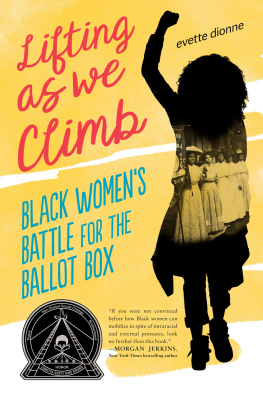Evette Dionne - Lifting as We Climb: Black Womens Battle for the Ballot Box
Here you can read online Evette Dionne - Lifting as We Climb: Black Womens Battle for the Ballot Box full text of the book (entire story) in english for free. Download pdf and epub, get meaning, cover and reviews about this ebook. year: 2020, publisher: Penguin Young Readers Group, genre: Politics. Description of the work, (preface) as well as reviews are available. Best literature library LitArk.com created for fans of good reading and offers a wide selection of genres:
Romance novel
Science fiction
Adventure
Detective
Science
History
Home and family
Prose
Art
Politics
Computer
Non-fiction
Religion
Business
Children
Humor
Choose a favorite category and find really read worthwhile books. Enjoy immersion in the world of imagination, feel the emotions of the characters or learn something new for yourself, make an fascinating discovery.
- Book:Lifting as We Climb: Black Womens Battle for the Ballot Box
- Author:
- Publisher:Penguin Young Readers Group
- Genre:
- Year:2020
- Rating:5 / 5
- Favourites:Add to favourites
- Your mark:
Lifting as We Climb: Black Womens Battle for the Ballot Box: summary, description and annotation
We offer to read an annotation, description, summary or preface (depends on what the author of the book "Lifting as We Climb: Black Womens Battle for the Ballot Box" wrote himself). If you haven't found the necessary information about the book — write in the comments, we will try to find it.
This Coretta Scott King Author Honor book tells the important, overlooked story of black women as a force in the suffrage movementwhen fellow suffragists did not accept them as equal partners in the struggle.
Susan B. Anthony. Elizabeth Cady Stanton. Alice Paul. The Womens Rights Convention at Seneca Falls. The 1913 Womens March in D.C. When the epic story of the suffrage movement in the United States is told, the most familiar leaders, speakers at meetings, and participants in marches written about or pictured are generally white.
Thats not the real story.
Women of color, especially African American women, were fighting for their right to vote and to be treated as full, equal citizens of the United States. Their battlefront wasnt just about gender. African American women had to deal with white abolitionist-suffragists who drew the line at sharing power with their black sisters. They had to overcome deep, exclusionary racial prejudices that were rife in the American suffrage movement. And they had to maintain their dignityand safetyin a society that tried to keep them in its bottom ranks.
Lifting as We Climb is the empowering story of African American women who refused to accept all this. Women in black church groups, black female sororities, black womens improvement societies and social clubs. Women who formed their own black suffrage associations when white-dominated national suffrage groups rejected them. Women like Mary Church Terrell, a founder of the National Association of Colored Women and of the NAACP; or educator-activist Anna Julia Cooper who championed women getting the vote and a college education; or the crusading journalist Ida B. Wells, a leader in both the suffrage and anti-lynching movements.
Author Evette Dionne, a feminist culture writer and the editor-in-chief of Bitch Media, has uncovered an extraordinary and underrepresented history of black women. In her powerful book, she draws an important historical line from abolition to suffrage to civil rights to contemporary young activistsfilling in the blanks of the American suffrage story.
Dionne provides a detailed and comprehensive look at the overlooked roles African American women played in the efforts to end slavery and then to secure the right to vote for women. Kirkus Reviews, starred review
Evette Dionne: author's other books
Who wrote Lifting as We Climb: Black Womens Battle for the Ballot Box? Find out the surname, the name of the author of the book and a list of all author's works by series.















